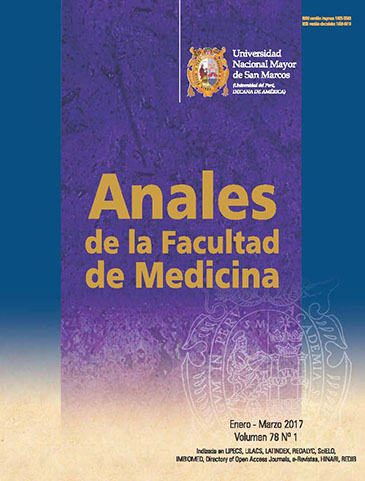Derivation and validation of an equation to determine cholesterol-low density lipoproteins in a population of Lima, Peru
DOI:
https://doi.org/10.15381/anales.v78i1.13020Keywords:
Low Density Lipoproteins, Coronary Heart Disease, Dyslipidemias.Abstract
Introduction: Various studies have shown a strong association between the increase in cholesterol low density lipoproteins (LDLc) serum concentration and the incidence of coronary heart disease. Objectives: To derive and validate the performance of a new equation to estimate the LDLc. Design: Observational and descriptive study. Institution: Hospital Edgardo Rebagliati Martins, Lima, Peru. Material: 4 644 lipid profile reports taken from the files of the hospital’s central laboratory, belonging to subjects of bot. sexes, between 18 and 75 years old. Interventions: The sample consisted of 4 644 lipid profile reports obtained from the files of the hospital’s central laboratory, and belonged to subjects of both sexes aged 18-75 years. It was divided into two groups: the first group was represented by 2 136 reports, and was used to derive the equation to estimate the LDLc by using multiple regression analysis; the second group comprised 2 508 reports that served to validate the performance of the new equation compared with the LDLc measurement by the homogeneous direct method and estimated by the Friedewald formula. Main outcome measure: LDLc serum concentration. Results: The Friedewald formula and the new equation underestimated the LDLc with a shortfall of 14.01 mg/dL and 5.52 mg/dL, respectively, with regard to the direct method. Systematic errors in the three clinical decision levels for LDL cholesterol were found to be higher for the Friedewald formula (12.6%, 12.0 %, and 11.7%) compared to the new equation (4.2%, 5.7% and 6.7%). The bias correction factor, which assessed accuracy, turned out to be higher and closer to the line of perfect match for the new equation, both in the whole sample and when the entire sample was stratified by levels of triglycerides. Conclusions: The new equation provided greater accuracy and lower analytical error compared to the Friedewald formula to estimate the LDL cholesterol in the three clinical decision levels and with different values of serum triglycerides.Downloads
Published
2017-05-16
Issue
Section
Artículo Original
License
Copyright (c) 2017 Italo Moisés Saldaña Orejón, Miguel Ángel Benites Ricra, Justhin Andrés Chipana Huallpa

This work is licensed under a Creative Commons Attribution-NonCommercial-ShareAlike 4.0 International License.
Those authors who have publications with this magazine accept the following terms:
- Authors will retain their copyrights and guarantee the journal the right of first publication of their work, which will be simultaneously subject to Creative Commons Attribution License that allows third parties to share the work as long as its author and its first publication this magazine are indicated.
- Authors may adopt other non-exclusive licensing agreements for the distribution of the version of the published work (eg, deposit it in an institutional electronic file or publish it in a monographic volume) provided that the initial publication in this magazine is indicated.
- Authors are allowed and recommended to disseminate their work over the Internet (eg: in institutional telematic archives or on their website) before and during the submission process, which It can produce interesting exchanges and increase quotes from the published work. (See El efecto del acceso abierto ).
How to Cite
1.
Saldaña Orejón IM, Benites Ricra M Ángel, Chipana Huallpa JA. Derivation and validation of an equation to determine cholesterol-low density lipoproteins in a population of Lima, Peru. An Fac med [Internet]. 2017 May 16 [cited 2024 Jul. 17];78(1):41-8. Available from: https://revistasinvestigacion.unmsm.edu.pe/index.php/anales/article/view/13020















